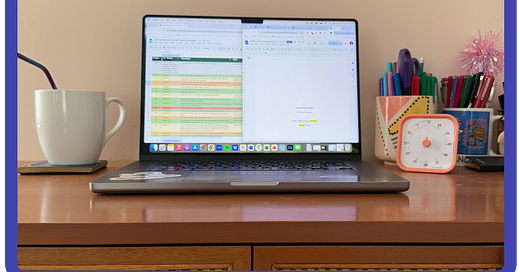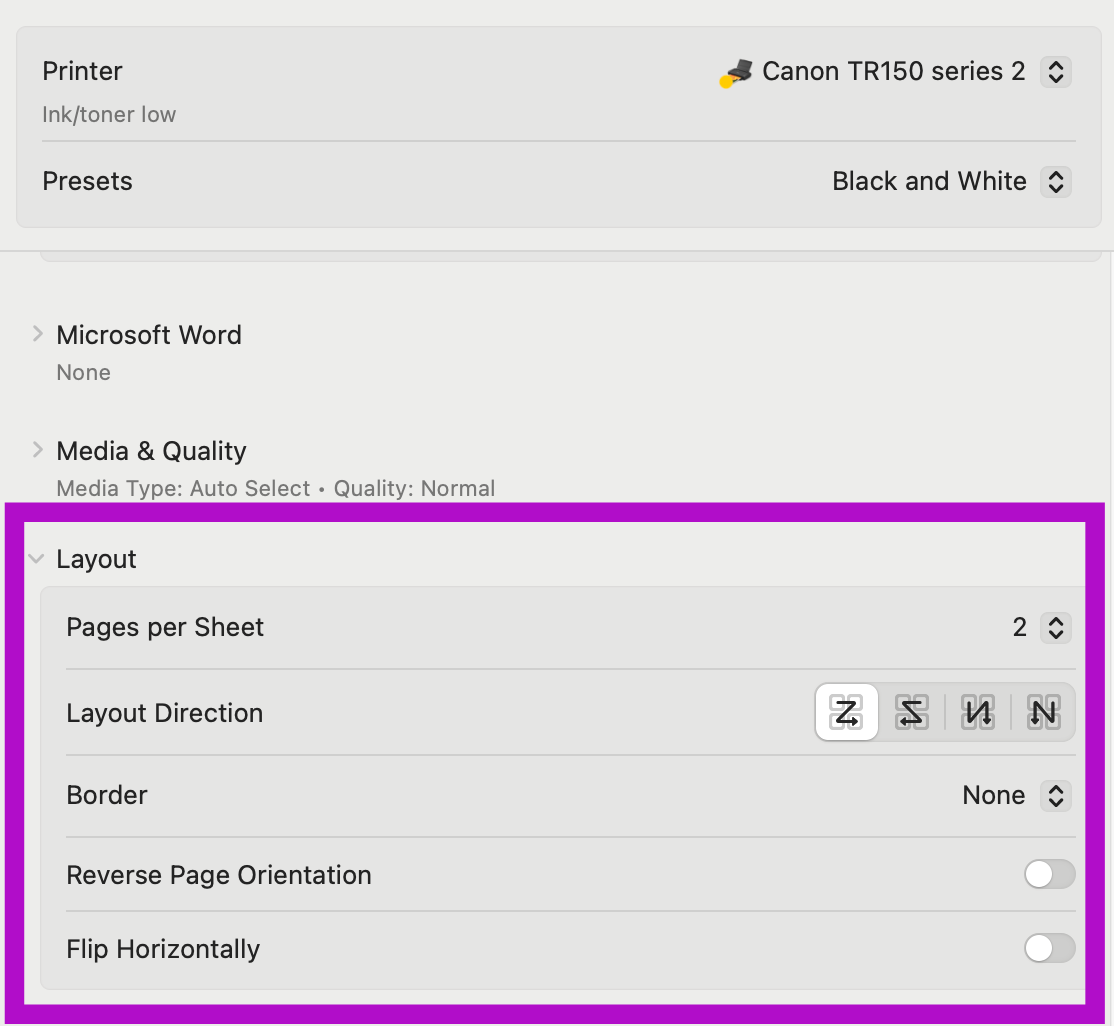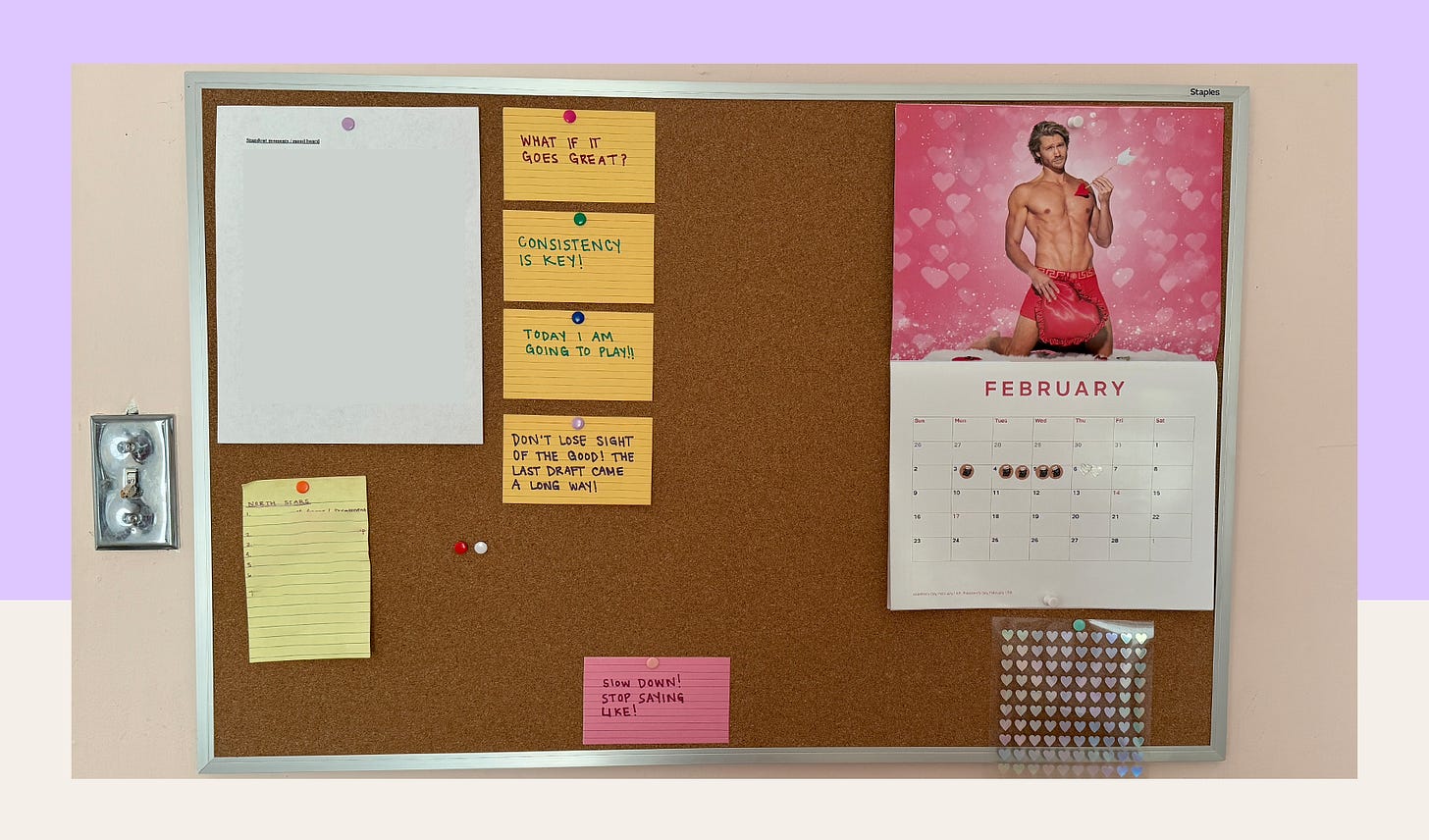Hi friends,
Usually, when someone asks me what they need to start writing a novel, I take pains to answer in a more monastic fashion than is reflected in my own day-to-day. You need nothing. Because, truly, there is no craft book, no piece of word processing software, no pen (no matter how perfect) that will make the process easier. The key is just to start.
But, as a person with a predilection for aesthetic office supplies, the truth is also that there’s lots of (non-essential) stuff involved in my daily writing routine. So, let’s take a tour of my proverbial office supply closet (complete with very amateurish photography—hey, it’s authentic!).
A note for paid subscribers: The bulk of this letter is free, but paid subscribers also get access to my digital novel tracking template and an explainer video on how I use it at the end. (This is a long one, so you’ll probably need to open it in your browser.)
For Writing On
Most writing happens on my laptop, but there’s still a shocking quantity of emotional support notebooks nearby.
A Crappy Notebook: Something about a fancy notebook makes me feel precious, so I bought this junky one at Duane Reade for brainstorm notes on my WIP novel.
A Beautiful Notebook: This notebook functions as part process journal and part regular journal. The goal is to have a less “rose colored glasses” account of how the book felt before it reached it’s final, perfected end state.1 I like that it’s larger than standard journal size.
My Five-Year Journal: I’ve gushed ad nauseum about my five-year journal, but I find it particularly helpful in my writing life. For example, in February, I’m re-reading entries from 2023 when I was starting the first draft and 2024 in the 3rd draft armed with initial beta reader feedback, while I write new entries for 2025 as I start the 5th draft. It’s a great reminder of how far I’ve come and also how cyclical my emotions are.
Legal Pads: My friend
swears by writing longhand (a tip she borrowed from Elin Hilderbrand), so I bought a bulk pack of colorful legal pads to test it out. My verdict: it’s not going my every day routine, but when I’m really stuck it helps to take myself away from the screen. On paper, there’s no typing and deleting the same sentence over and over, and telling myself I’ll get another chance to edit when I transpose the words to my computer makes it feel lower stakes. Plus, there’s something satisfyingly old school about dramatically ripping away a page and crumpling it up if you want to start over.Large, Lined Sticky Notes: These are the perfect size for to-do lists. I’m of the mind that if you have more things to do than fits on one of these, you need to cull down your list.
Index Cards: I use these for my pinboard, see below. I love that they’re lined because slowly slanting handwriting is my sleep paralysis demon.
Wide Sticky Notes: Sometimes—usually in a 2nd or 3rd draft—I take my whole novel and write a sticky note for each chapter and put it up on a wall so I can visually see the shape of the novel and think about what scenes are missing, need to move around, or to get cut.
For Writing With
I’m a bit of a pen collector (some might say hoarder—though felt tip only, please), so we’ll only chat about the MVPs.
Marvy Le Pen: I use these extra fine tip (0.3mm) pens for cramped spaces (notes in the margins, my five year journal). They dry out or wear down fairly quickly, so I wouldn’t use them as my workhorse pen for, say, longhand novel writing. I like the red for marking up manuscripts (feels very official) and pick a new “color of the year” for my 5-year journal (currently emerald). If you want to experiment, this multi-pack is the stuff of Virgo dreams.
Sakura Pigma Micron 05: This is my go to pen. Writing a list? Writing in my regular journal? Writing a thank you note? It’s going to be with one of these. The tip is a bit thicker (0.45mm) than the Le Pen, and as far as I’m concerned, the thicker the pen, the better my handwriting looks, which I care about more than average. There are some good colors, but not as many as the Le Pen.
Paper Mate Flair: This is the workhorse pen. (I’ve also been told it’s the preferred pen for teachers.) They’re cheap and they do the job, even if I prefer a Micron.
Zeyar Pastel Highlighters: I go through a lot of highlighters annotating books for research and marking up my own manuscripts and these are my favorites. (Amazon tells me I’ve repurchased them 5 times.) I appreciate that the colors aren’t blinding.
Stabilo Green Highlighters: Sometimes I take a green highlighter to my own drafts to note the things I like and remind myself there is good, even if what I’m focused on fixing is the… less good. So, I go through green highlighters at a faster clip than other colors. This is one of the only all-green packs I’ve found.
Fine Point Sharpies: I went through a whole journey before my first novel came out to figure out my preferred signing pen. I landed on a neon pink sharpie (again, the thicker the pen, better my handwriting looks). I also use these for cork board notes.
For Printing Your Words
I firmly believe that experiencing your own writing on paper is totally different than encountering it on a screen. And it’s heartening to see a thick stack of pages filled with your words—you did that! Historically, I’ve been a Staples frequent flyer, skipping off to my local to print and bind early drafts (later drafts with smaller changes are easier for me to do digitally). But the costs add up—printing usually runs $75 - $100 a pop—so I’ve mastered my own at-home printing set up.
Canon Printer: This little wifi-enabled printer is compact enough to fit under my desk, but sturdy enough to print a 300-page manuscript without fuss. Also: incredibly handy for printing return shipping labels.
Electric 3-Hole Punch: I find operating this battery-powered 3-hole punch to be oddly satisfying. It’s only meant to do 20 pages at a time, so it takes a few rounds.
2” Binder: Pop the whole manuscript in a 2” binder. Even when my draft was 106K words (a standard adult contemporary novel is 70-90K), it still fit fine.
Ink Cartridges: Brand name ink is $$$, but no-name ink from Amazon is pretty damn reasonable. One black ink cartridge is more than enough for a printed manuscript (maybe even two).
Print Settings: Are you cringing at the paper waste here? Because same. To attempt to mitigate this I typically print 2 manuscript pages to a single printed page, which is still plenty legible for me. On the print menu for Word on a Mac, there’s a section called “Layout.” If you expand this section, you can select 2 pages per sheet.
Digital Tools
Laptop: My tech setup isn’t particularly elaborate or ergonomic. Until recently, I worked from my dining room table, so I didn’t want an external monitor or keyboard crowding my living area, and now I’m used to the small(ish) screen life. I work on a 16-inch MacBook Pro (the largest built-in display they made when I bought it in 2021). It’s heavy for travel, but I appreciate the larger screen size day-to-day.
Word Processor: I use Google Docs in my early drafts, so I don’t have to worry about saving. However, the publishing industry standard is Microsoft Word. Once I get into later drafts with lots of line edits from my editor, I switch over. Some writers swear by Scrivener, a writing software designed for book writing, but it feels over-complicated to learn and unnecessary to my process.
My Google Sheets Novel Tracker: If you know me, you know there’s going to be a calendar invite for every social outing and a spreadsheet for any major project. It’s just who I am. I use this for word count tracking, timeline tracking, and macro outline and edit planning. As mentioned, I’m sharing the template and a video walkthrough with paid subscribers below.
Miscellanea
Sticky Tabs: There are cheaper versions, but I appreciate that these come with their own booklet so they don’t get roughed up if I travel with them. I mostly use them for annotating books for research, but also have a few in my cheap notebook to mark different pages I’m using concurrently.
Time Timer: This timer (that’s absolutely intended for children, btw) is my procrastination superhero. If I’m feeling particularly resistant to work, I’ll set it for some amount of time (usually 20 minutes or an hour) and tell myself, “You can do anything for X minutes.” It turns out I’m right and I can. And once I’m under way, the work feels less daunting.
Candle: I don’t want to turn myself into a princess-and-the-pea-type writer who can only write when the humidity is exactly 56% and I’m wearing lucky socks, but I like a little bit of ritual. I keep a candle in my office—currently, Brooklyn Candle Studio’s Apple Cider candle, which was seasonal and is sold out, sorry!—and on a good day, the act of lighting it signals to my brain that it’s time to work.
Cork Board: The newest addition to my writing setup is a cork board above my desk where I keep some writing mantras and reminders (top to bottom: “What if it goes great?”, “Consistency is key!”, “Today I am going to play!!”, and “Don’t lose sight of the good! The last draft came a long way!”). I blocked out the left-most two pages because they’re deeply spoiler-filled (a mood board of stand out quotes compiled by my editor and a 2-ish year old Post It with thematic “North Stars” for my WIP). I’ve also started using the sticker/calendar method described here to visually track progress. My inner Scholastic Book Fair kid deeply appreciates any progress tracked with a sticker. I’m using these and these.
Sadly, the Chad Michael Murray The Merry Gentleman calendar—one of my weirdest and most treasured possessions—was part of a PR mailer and not available for sale.
















